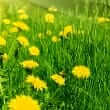Background
- Dandelion is a member of the Asteraceae/Compositae family closely related to chicory. It is a perennial herb native to the Northern hemisphere and found growing wild in meadows, pastures, and waste grounds of temperate zones. Most commercial dandelion is cultivated in Bulgaria, Hungary, Poland, Romania, and the United Kingdom.
- Dandelion was commonly used in Native American medicine. The Iroquois, Ojibwe, and Rappahannock prepared the root and herb to treat kidney disease, upset stomach, and heartburn. In traditional Arabian medicine, dandelion has been used to treat liver and spleen ailments. In traditional Chinese medicine (TCM), dandelion is combined with other herbs to treat liver disease, to enhance immune response to upper respiratory tract infections, bronchitis, or pneumonia, and as a compress for mastitis (breast inflammation).
- Dandelion root and leaf are used widely in Europe for gastrointestinal ailments. The European Scientific Cooperative on Phytotherapy (ESCOP) recommends dandelion root for the restoration of liver function, to treat upset stomach, and to treat loss of appetite. The German Commission E authorizes the use of combination products containing dandelion root and herb for similar illnesses. Some modern naturopathic physicians assert that dandelion can detoxify the liver and gallbladder, reduce side effects of medications metabolized (processed) by the liver, and relieve symptoms associated with liver disease.
- Dandelion is generally regarded as safe with rare side effects including contact dermatitis, diarrhea, and gastrointestinal upset.
- Dandelion is used as a salad ingredient, and the roasted root and its extracts are sometimes used as a coffee substitute.
References
Natural Standard developed the above evidence-based information based on a thorough systematic review of the available scientific articles. For comprehensive information about alternative and complementary therapies on the professional level, go to . Selected references are listed below.
- Akhtar MS, Khan QM, Khaliq T. Effects of Portulaca oleracae (Kulfa) and Taraxacum officinale (Dhudhal) in normoglycaemic and alloxan-treated hyperglycaemic rabbits. J Pak Med Assoc 1985;35(7):207-210.
View Abstract - Baba K, Abe S, Mizuno D. [Antitumor activity of hot water extract of dandelion, Taraxacum officinale-correlation between antitumor activity and timing of administration (author's transl)]. Yakugaku Zasshi 1981;101(6):538-543.
View Abstract - Chakurski I, Matev M, Koichev A, et al. [Treatment of chronic colitis with an herbal combination of Taraxacum officinale, Hipericum perforatum, Melissa officinaliss, Calendula officinalis and Foeniculum vulgare]. Vutreshni bolesti 1981;20(6):51-54.
View Abstract - Chen Z. [Clinical study of 96 cases with chronic hepatitis B treated with jiedu yanggan gao by a double-blind method]. Zhong Xi Yi Jie He Za Zhi 1990;10(2):71-4, 67.
View Abstract - Greenlee H, Atkinson C, Stanczyk FZ, et al. A pilot and feasibility study on the effects of naturopathic botanical and dietary interventions on sex steroid hormone metabolism in premenopausal women. Cancer Epidemiol Biomarkers Prev 2007;16(8):1601-1609.
View Abstract - Hata K, Ishikawa K, Hori K, et al. Differentiation-inducing activity of lupeol, a lupane-type triterpene from Chinese dandelion root (Hokouei-kon), on a mouse melanoma cell line. Biol Pharm Bull 2000;23(8):962-967.
View Abstract - Ingber A. Seasonal allergic contact dermatitis from Taraxacum officinale (dandelion) in an Israeli florist. Contact Dermatitis 2000;43(1):49.
View Abstract - Jovanovic M, Mimica-Dukic N, Poljacki M, et al. Erythema multiforme due to contact with weeds: a recurrence after patch testing. Contact Dermatitis 2003;48(1):17-25.
View Abstract - Kim HM, Oh CH, Chung CK. Activation of inducible nitric oxide synthase by Taraxacum officinale in mouse peritoneal macrophages. Gen Pharmacol 1999;32(6):683-688.
View Abstract - Kim HM, Lee EH, Shin TY, et al. Taraxacum officinale restores inhibition of nitric oxide production by cadmium in mouse peritoneal macrophages. Immunopharmacol Immunotoxicol 1998;20(2):283-297.
View Abstract - Mascolo N, Autore G, Capasso F, et al. Biological screening of Italian medicinal plants for anti-inflammatory activity. Phytotherapy Res 1987;1(1):28-31.
- Merino AJ, Amerigo Garcia MJ, Alvarez RL, et al. [Human fascioliasis with atypical severe presentation. Treatment with triclabendazole]. Enferm Infecc Microbiol Clin 1998;16(1):28-30.
View Abstract - Racz-Kotilla E, Racz G, Solomon A. The action of Taraxacum officinale extracts on the body weight and diuresis of laboratory animals. Planta Med 1974;26(3):212-217.
View Abstract - Schutz K, Carle R, Schieber A. Taraxacum--a review on its phytochemical and pharmacological profile. J Ethnopharmacol 10-11-2006;107(3):313-323.
View Abstract - Wakelin SH, Marren P, Young E, et al. Compositae sensitivity and chronic hand dermatitis in a seven-year-old boy. Br J Dermatol 1997;137(2):289-291.
View Abstract







